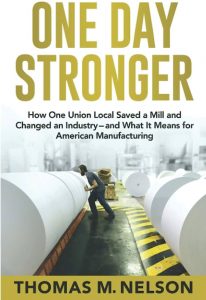One Day Stronger: How One Union Local Saved a Mill and Changed an Industry — and What It Means for American Manufacturing
 One Day Stronger: How One Union Local Saved a Mill and Changed an Industry-and What It Means for American Manufacturing by Thomas M. Nelson (Rivertowns Books, Irvington, NY, 2021)
One Day Stronger: How One Union Local Saved a Mill and Changed an Industry-and What It Means for American Manufacturing by Thomas M. Nelson (Rivertowns Books, Irvington, NY, 2021)
The massive loss of good-paying unionized manufacturing jobs in the U. S. over the past five decades has been well documented. Workers and unions have bemoaned the devastating effects of these losses on families and communities, identifying free trade policies, globalization, disinvestment, and corporate greed as the principal culprits creating these social ills. Most business leaders, government officials, economists, and other analysts also lament these losses but tend to regard them as a regrettable but unavoidable result of larger social forces and the “creative destruction” associated with capitalism.
Thomas M. Nelson, the Outagamie County Executive in northeastern Wisconsin, presents a different twist on this familiar story. In One Day Stronger, he provides a participant’s perspective on a spirited labor-community campaign that averted the closing of a century-old paper factory in the state’s Fox River Valley. Nelson believes this campaign has implications beyond Wisconsin, arguing that the preservation of the Appleton Coated Mill offers powerful insights regarding the future of American manufacturing, the revival of the union movement, and the potential to reshape American politics along class lines.
Nelson recounts the evolution of paper manufacturing in the Fox River Valley, its status as one of the few remaining domestic industries with high union density, and its integral role in sustaining a strong regional economy. He acknowledges the competitive challenges faced by the industry and its need to modernize, develop new products, and seek new markets. However, private equity firms and multinational corporate ownership more concerned with short-term profit over long-term investment hindered these efforts, leading to increased labor-management strife, plant closures, and disruption in the communities where job losses occurred. In Appleton Coated’s case, a French company sold the firm to a committed group of local managers, but the bank that oversaw its loans refused to continue supporting the company as it sought new customers amid rising pulp prices that negatively affected the company’s bottom line.
As an ardent pro-labor Democrat determined to protect the paper industry and the communities reliant on its presence, Nelson sprang into action when the century-old Appleton Coated Mill went into receivership in the fall of 2017. Wisconsin’s receivership law provided an opening for stakeholders to object to the company’s sale based on considerations of community impact. This provision allowed Nelson and the United Steel Workers local that represented Appleton Coated’s workers to mount a multi-pronged campaign to save the plant. Nelson offers a primer on the intricacies of the receivership process and the roles that consultants, attorneys, banks, and corporations played in determining Appleton Coated’s future. To his surprise and delight, a conservative judge did not rubber-stamp the sale. Although the judge approved an agreement to sell the company to a California-based industrial scrap dealer, he granted Appleton Coated a reprieve, allowing it 90 days to find a “going concern buyer” prepared to invest in the company and give it a chance for survival. Ultimately, the scrap iron dealer decided to devote resources to Appleton Coated. Instead of becoming another shuttered factory, the company made a solid turnaround, supported by a new collective bargaining agreement and a “highly productive unionized workforce” that Nelson describes as “one of the mill’s most important assets.” Unions also played an indispensable role in saving several other area paper factories, providing what Nelson calls “an infrastructure by which the rights of working people can be vindicated.”
The fight to save Appleton Coated occurred in the broader context of Wisconsin’s politics which shifted sharply to the right under Governor Scott Walker. Nelson blasts Walker and his allies for refusing to help the paper industry while providing electronics manufacturer Foxconn with massive subsidies in return for promises of jobs that failed to materialize. For Nelson, the Foxconn fiasco represented a disastrous approach to economic development that enriched corporations at the expense of workers, while leaving a bellwether industry to fend for itself. Nelson explains how this approach coincided with the decline of the union movement over the past half-century, limiting workers’ ability to influence the decisions of capital. Chiding his fellow Democrats for their complacency, Nelson urges them to deepen their connections to workers and unions and embrace a class-oriented politics akin to the progressive, farmer-labor party alliances once so powerful in the Midwest.
However, Nelson’s historical analysis of labor politics in the Midwest leaves an important unanswered question. As he observes, Wisconsin has produced staunch progressives such as the LaFollette family, Gaylord Nelson, and Russ Feingold. It has also generated ultra-conservatives such as Scott Walker, Joe McCarthy, and Ron Johnson, all of whom garnered working-class support. Although the Appleton Coated example demonstrates the potential of class-based labor-community alliances, the social divisions inhibiting these alliances in Wisconsin and other midwestern states warrant further attention.
Nelson concludes on an optimistic note, citing the campaign to save Appleton as “a model for building a grassroots and political movement that can help change our country.” He sees the paper industry as the harbinger of an industrial renaissance based on technological innovation, the development of eco-friendly products, and the successful pursuit of new markets. Nelson insists that these efforts must be accompanied by union representation and a strong worker voice that can help shape managerial decisions. Although these circumstances may be hard to replicate, Nelson’s inspiring account shows how committed elected officials, determined and creative unions, and their allies might revive American industry and lead us in a “new and better economic direction.”
Reviewed by Bob Bussel, Professor Emeritus, Department of History and Labor Education and Research Center, University of Oregon
